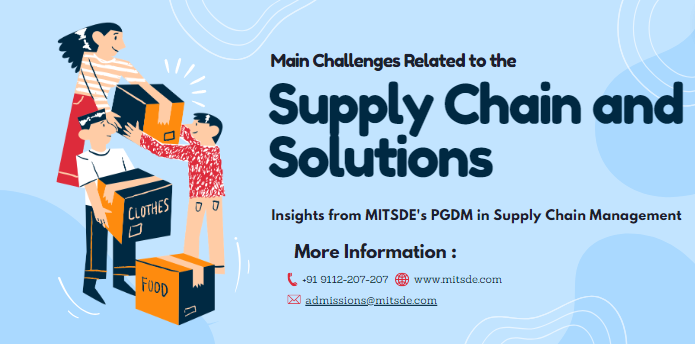
The global supply chain landscape is fraught with challenges that demand strategic solutions. Companies must navigate complexities such as disruptions, visibility issues, demand forecasting inaccuracies, sustainability concerns, cost management, technological integration, and global trade compliance.
Here’s a look at these challenges and how MITSDE’s PGDM in Supply Chain Management can equip professionals to tackle them effectively.
1. Supply Chain Disruptions
Challenge
Disruptions caused by natural disasters, geopolitical events, and pandemics can halt production, delay shipments, and lead to inventory shortages.
Solution
To mitigate disruptions, companies need to diversify their supplier base, use advanced predictive analytics for forecasting, build strong supplier relationships, and invest in risk management strategies.
MITSDE’s Approach
The PGDM in Supply Chain Management at MITSDE covers risk management strategies and the use of predictive analytics, preparing students to identify and mitigate potential disruptions. Courses on global supply chain management teach how to build resilient supply chains through diversification and strategic planning.
2. Supply Chain Visibility
Challenge
Lack of visibility into the supply chain can lead to inefficiencies, higher costs, and delayed responses to issues.
Solution
Investing in digital technologies like IoT, blockchain, and advanced analytics enhances visibility, providing real-time tracking and data sharing.
MITSDE’s Approach
MITSDE’s program includes modules on supply chain technologies, focusing on IoT, blockchain, and advanced analytics. Students learn to implement these technologies to achieve real-time tracking and improved visibility.
3. Demand Forecasting
Challenge
Fluctuating consumer demand and market unpredictability make accurate demand forecasting challenging, often leading to overstocking or stockouts.
Solution
Leveraging machine learning algorithms and big data analytics improves forecasting accuracy. Collaborative forecasting with key partners aligns supply and demand more effectively.
MITSDE’s Approach
The curriculum incorporates advanced data analytics and machine learning for supply chain forecasting. Collaborative projects with industry partners provide hands-on experience in aligning supply and demand.
4. Sustainability and Environmental Concerns
Challenge
Increasing pressure for sustainable practices requires companies to minimize their environmental impact, including reducing carbon footprints and managing waste.
Solution
Adopting green logistics, eco-friendly packaging, renewable energy, and circular economy principles helps reduce environmental impact.
MITSDE’s Approach
MITSDE emphasizes sustainable supply chain practices, teaching students about green logistics, eco-friendly packaging, and circular economy principles. Courses on corporate social responsibility and sustainability prepare students to lead environmental initiatives.
5. Cost Management
Challenge
Rising costs of raw materials, labor, and transportation put pressure on supply chain budgets.
Solution
Streamlining operations through lean manufacturing, automation, strategic sourcing, and long-term supplier contracts helps manage costs effectively.
MITSDE’s Approach
The program covers lean manufacturing principles, automation, and strategic sourcing. Financial management courses provide insights into cost control and budgeting within the supply chain context.
6. Technological Integration
Challenge
Integrating new technologies into existing systems can be complex and costly, requiring significant investment and expertise.
Solution
Developing a clear digital transformation strategy, prioritizing investments in aligned technologies, and collaborating with technology partners facilitate successful integration.
MITSDE’s Approach
MITSDE’s PGDM program includes a focus on digital transformation strategies and technology integration. Students learn to evaluate and implement technologies that enhance supply chain efficiency and innovation.
7. Global Trade Compliance
Challenge
Navigating global trade regulations, tariffs, and customs procedures is complex and can result in costly fines, delays, and reputational damage if not managed properly.
Solution
Implementing robust compliance management systems, staying updated on regulations, and using automated trade management solutions streamline processes and reduce risks.
MITSDE’s Approach
The curriculum addresses global trade compliance, covering international trade regulations, tariffs, and customs procedures. Students learn to implement compliance management systems and use automated solutions to ensure smooth operations.
Conclusion
How MITSDE Prepares Supply Chain Leaders
MITSDE’s PGDM in Supply Chain Management equips students with the knowledge and skills to address contemporary supply chain challenges. The program combines theoretical knowledge with practical applications, ensuring graduates are ready to implement effective solutions in their organizations. Through a blend of advanced analytics, technological integration, risk management, sustainability practices, and global compliance, MITSDE prepares future supply chain leaders to build resilient, efficient, and sustainable supply chains.
Call to Action
Are you ready to transform your career and tackle the complex challenges of modern supply chains? Enroll in MITSDE’s PGDM in Supply Chain Management and become a leader in driving innovation and efficiency in the supply chain industry. Visit our website for more information and to apply today!


